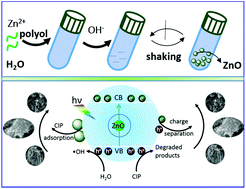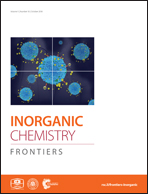Extremely rapid engineering of zinc oxide nanoaggregates with structure-dependent catalytic capability towards removal of ciprofloxacin antibiotic†
Abstract
Although significant advances in the tailoring of nanocrystallite aggregates have been achieved, the synthesis of aggregates is strongly dependent on the use of templates, surfactants, and additives. Herein, direct rapid fabrication of ZnO nanoaggregates in a green and environmentally friendly polyol–H2O medium is developed. Remarkably, the rapidly formed ZnO nanoaggregates can be engineered by controlling the types of polyols as well as the volume ratio of polyol to water. The amount of water in the nonaqueous polyol solution is the key to inducing the desired structure and surface areas of ZnO nanoaggregates. The variations in the crystal structure of ZnO nanoaggregates are investigated in detail by powder X-ray diffraction, scanning electron microscopy, and transmission electron microscopy. The effects of different ZnO structures on the catalytic capability are evaluated through photodegradation of ciprofloxacin (CIP) antibiotic under simulated solar light irradiation. The nanoparticle aggregates show the highest photocatalytic performance, and the photoinduced h+ and ˙OH are the predominant active species in the photocatalytic degradation of CIP. The enhancement of the photocatalytic capability of the ZnO nanoparticle aggregates compared to other nanostructures is mainly attributed to their unique structure, efficient electron–hole separation, and faster charge carrier transport, on the basis of photoluminescence spectra, photocurrent measurements, and electrochemical impedance spectroscopy. The polyol-mediated engineering of ZnO nanoaggregates could provide insights into the synthesis of other nanoaggregate-based single and hybrid functional structures.



 Please wait while we load your content...
Please wait while we load your content...